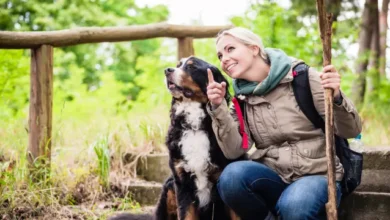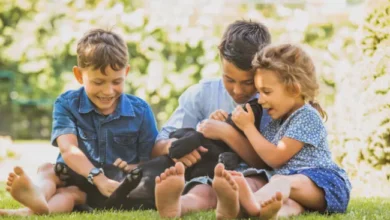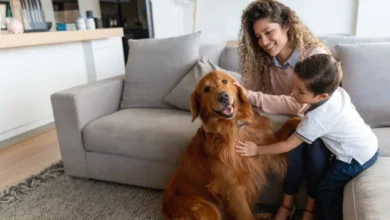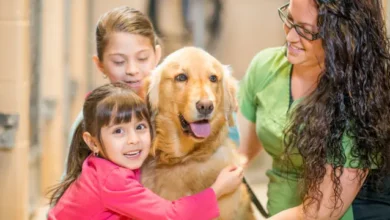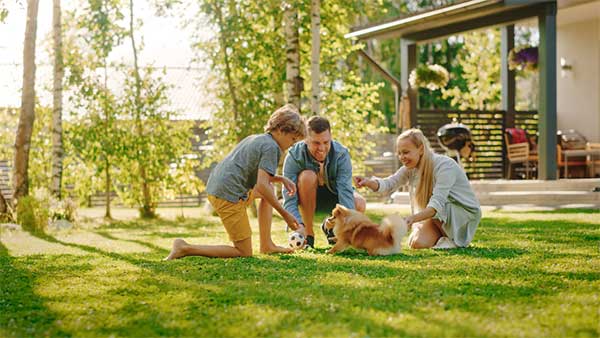
Congratulations, you have decided to become a pet parent. You have made one of the best decisions of your life by giving yourself the companionship and affection of unconditional love from another being.

You have researched the breed of dog you want to adopt, researched the breeder, and finally have landed on the puppy that will be your furbaby.
Now comes the first big important step in preparing your home for the dog. Are you ready to welcome your puppy? Have you ‘puppy-proofed the place? Have you gotten all the things you need for your new baby? Yes, the preparations for a puppy are not that different than preparing for a human baby.
Read More:
- Puppy Growth
- 6 Things To Do Before Bringing Your New Dog Home
- 5 Tips To Welcome Your New Puppy Into Your Home
- 8 Things Your New Puppy Needs for the Best Start
- How to Prepare to Bring Your New Dog Home!
- 18 Tips to Keep Your Pet Healthy and Happy
In this post, we will walk you through everything you need to prepare for the new puppy’s arrival.
Table of contents
- how to prepare for new puppy?
- Checklist of Actions to organize
- Puppy Proofing Your House
- Step 1: Keep your garbage out and contained
- Step 2: Take care of the electrical wirings
- Step 3: Put bags out of reach
- Step 4: Shoes out of sight
- Step 5: Designate Puppy spaces
- Step 6: Puppy guard toilet seats and cabinet doors
- Step 7: Make your house a poison-free home
- Step 8: Address the house plants and the fish tank
- Step 9: Train/Assess your other pets
- Step 10: Puppy-proof Your Garden & Yard
- Prepare the Family
- Plan Outside Resources
- Final Thoughts
how to prepare for new puppy?
First, let’s start with a checklist of stuff you need to get for your puppy’s arrival.
- Food and water bowl: Get a bowl set that does not tip over and cannot be easily picked up by the puppy. The set that sits on a metal stand is ideal. If you are planning on using a crate, get a food and water bowl set for the crate as well (however, this should be separate bowls and not attached).
- Food mat: This is important to manage the spills of food and water on the floor. The mat will also help the puppy designate his feeding station.
- Dog bed: You will need a dog bed for the puppy. Ideally, you should get two – one for the living room where he will spend most of his time with you and one for the bedroom where he will sleep at night.
- Crate: A crate is essential in training a puppy for housetraining and separation anxiety
- Collar: You will need this to be able to take your puppy outside. Get an adjustable collar so you can use it throughout the puppy’s growth into adult sizes.
- Leash: You also needed to walk your dog. Get retractable leashes to teach walking on a lead but also letting them sniff around. Leash training is another essential part of raising a puppy.
- Food: First, you have to continue with the food the puppy is used to eating. You can eventually consult your veterinarian on the right puppy food you will need for your new furry friend.
- Treats: It is a great way to train your puppy and reward them for successfully learning a lesson from your training. For more information read this article on our blog.
- Toys & Chews: As soon as the puppy enters the home, he will be inquisitive and try to play with everything in the house. So it is important to get them toys and chew toys to start training them to stick to toys. Be sure to buy sturdy.
- Pet hair brush: you will need to start routine grooming early on with the puppy.
- Gentle shampoo: Pick a dog shampoo with natural ingredients and fragrance-free and gentle for delicate puppies
- Toothbrush and Paste: again, you will need to get the puppy in the habit of having his teeth brushed regularly
- Puppy gates/playpens: another important tool to confine your puppy in a safe space for potty training and training to stay at home alone.
Now that we have covered the basic stuff you will need to stock up on for your puppy, and it is time for an action checklist.
Checklist of Actions to organize
Following is a checklist of actions you need to take to organize external resources for the puppy:
Puppy Proofing Your House
The little bundle of joy you are about to bring to your home will be your best friend for years to come. He will be the best dog you ever had one day. But before that happens, there will be a challenging period of training the puppy.
Puppies are curious. They will get into anything and everything to explore and discover the world around them. This is a very natural part of their growing up. This is how they develop their instincts and senses. A puppy’s inquisitive nature should be encouraged and nurtured to help the puppy learn about his environment and the training lessons you are going to teach him.
The journey of puppy training is fairly long and requires diligence and patience. It also requires puppy-proofing the home. Let’s explore the steps you need to take to puppy-proof your home.
Step 1: Keep your garbage out and contained
Puppies love to explore new scents and smells. The garbage in your house has all sorts of interesting smells for the puppy to be curious about. So, now is the time to take care of the garbage collection system in your house.
Take a look where you place garbage bins in the house – the kitchen, the bathrooms, your home office, the bedrooms. Then make sure the bins have lids that can be opened with an effort (either the tap of your foot or you physically lifting the lids). Where needed, replace open-faced garbage bins with ones with lids. For example, consider placing your kitchen garbage bin inside the cupboard under the sink that requires effort to open. You will need to get in the habit of taking out your garbage before leaving the house with the puppy unattended or unsupervised. At the very least, you will need to keep the garbage out of the puppy’s reach.
The garbage bins are also sources of bacteria, and they all have some discarded material that is harmful to the dog. This is why it is important to manage the garbage situation in the house.
Step 2: Take care of the electrical wirings
As the puppy explores his surroundings, you will see his curiosity leading to play and chewing different stuff. This is why you need to be prepared to offer them chew toys and chewable treats. They will also find ways to get to your electrical wiring, charging cables, internet cables, and things like that.
This is the time to take stock of the cables and wirings all over the house. Tie up any tangled-up cables and wirings. Be sure to keep them out of reach of a puppy – by hiding them behind heavy furniture that the puppy won’t be able to move.
The material in cables and wires are not meant for dogs and will cause them serious damage. So, as a puppy parent, you have to safeguard your puppy from cables/wires.
Step 3: Put bags out of reach
Another area of curiosity for dogs will be your bags – gym bags, purses, office bags, laptop bags, makeup bags, school bags, hockey, or other sports bags, and you name it. These bags often have your scents associated with them. This makes them curious about the bags and explores them.
Of course, that is not good for them. They can find all sorts of equipment, makeup, hygiene and grooming products, and in some cases, food items like chewing gums and breath fresheners or snack bars. These all pose a serious risk if your puppy ingests them. Not only is it bad to chew on it or consume it, but some of the stuff can also even obstruct their bowels and intestines that can be fatal.
So it is time to take stock of the bags around the house and come up with a policy to keep bags out of reach. Talk to each family member about the importance of putting away their bags in closets and close the doors or hang them up where they belong.
Step 4: Shoes out of sight
Yet another area where your scents will linger are your shoes. Your dog will be naturally curious about these areas. They also love chewing on shoes as a way of coping with separation anxiety. So, it is time to put away the shoes out of their sight. Create shoe storage spaces in the closet and instruct each member of the family that they can no longer just leave shoes out.
After all, those Mahnolos or Pradas don’t deserve to end up in your puppy’s belly. Not to mention they can obstruct their digestive tract causing serious damage.
So, time to come up with a shoe storage policy and stick to it. Keep them locked up behind closed doors or drawers where your dog can’t access them.
Step 5: Designate Puppy spaces
It will be important for the puppy to have some safe spaces to rest and feel secure. They will also need confined spaces for the potty training and house training phase. Designate puppy spaces in the house – where they will sleep while you are away, where they will use puppy pads for training, and where they will sleep and play.
Discuss with your family the designated spaces and use the puppy gates, playpens, or crates to design those spaces for the puppy’s comfort. How much space you designate is dependent on the breed of dog you get and how big the puppy is.
Step 6: Puppy guard toilet seats and cabinet doors
As the puppy roams their environment and gets confident of his surroundings, he will level up to trying new tricks. This can be quite the fun phase as you see them trying to figure out ways around obstacles and train their agility and intelligence.
However, this is also when they will try to nudge open a cabinet door or a toilet seat to explore what’s in them. That is a big no from a pure health, hygiene, and safety perspective.
You need to look into puppy guarding toilet seats and cabinet doors just like your baby would proof them. You have one of two ways to tackle this. You can do this by ensuring the dog is always confined to certain rooms or installing puppy guard locks on these surfaces.
You can establish a habit of confining the puppy to living rooms and bedrooms and not allow them into the bathrooms or kitchens. However, that will start to get tedious and difficult and not always manageable. So, the next step should be to buy toilet locks and guards and install them on toilet seats and cabinet doors where the puppy can reach.
Read More: Beagle Pitbull Mix
Step 7: Make your house a poison-free home
This should go without saying but needs mentioning because this is a critical step. You need to ensure the house is a poison-free home. If you have had pest control like mousetrap or ant traps, it is time to get rid of that. Take stock of your cleaning products and toiletries. Store the products away from the dog’s reach.
Take special care of what floor cleaning solution you will be using as not all products are safe for puppy paws.
Some of the items that can be poisonous to the puppy and therefore need to be restricted or put away carefully are:
- Dish detergent
- Dishwashing liquid
- Toilet cleaner
- Floor cleaning solutions
- Shampoo and soaps
- Shaving foams and blades
- Hair gel and spray
- Glass cleaner
- Degreaser
- Oven cleaner
- Sprays and foams
Take stock of all these products, ensure they are pet-friendly, and won’t cause irritation to the dog’s skin, coat, paws, etc. Also, ensure all of these products are placed in a cabinet with a lock or guard on them. Complete this step with an inspection of how poison-free your home is for the puppy. Ingesting any of these products can be fatal and will result in a heartbreaking loss and pain.
Step 8: Address the house plants and the fish tank
You can almost be guaranteed that your dog will be curious about your house plants and fish tanks. It is time to pay attention to them. Research if the plants in the house are poisonous for your dog. If they are, it is time to rehome the plants. In terms of the fish tank, secure them in a place where the puppy can’t knock them over or get in.
Step 9: Train/Assess your other pets
Don’t forget your other pets. If you have a cat or another dog, it will be important to research how to introduce them to your new dog. Start the process of introducing them to other dogs. Perhaps invite your friend over for a play date with their dog and see how the other pets interact with a new animal in the house.
It will be very important to help your other pets adjust to the new puppy for the safety and security of all parties involved. If in doubt, you can consult a pet trainer as well.
If you haven’t trained your first dog already on some good dog habits, the time to train them is now. You do not want the bad habits of one of the dogs to be imprinted on the new puppy.
Step 10: Puppy-proof Your Garden & Yard
You know your puppy will be spending a good portion of your time together in the garden or yard. Besides doing their potty business, they will love the piece of outdoors all to themselves to roam about off-leash and explore. A part of that will be their curious nature about different-smelling plants and flowers, and yes, you guessed it – chew them!
So, it is time to puppy-proof your garden. Research the plants you have in the garden to check to see if they are poisonous for your dog. If they are, you are best to get rid of them. However, if it is an established shrub and contributes to your garden in a significant way, you will need to put puppy fencing around that area of the plant to keep the dog away.
Garden fencing is a good idea to keep certain parts of the garden as off-limits. These areas would be your vegetable and herb garden, your flower garden, and any water feature or coy ponds. Be sure to research the perfect height garden fencing to keep your puppy away.
You can also opt to get electric fencing to keep your dog away. This will require more committed training and should only be done with expert advice.
Now that we have discussed the steps you can take around the house to make a safe home for your new furbaby, let’s talk about preparing your family for the new puppy.
Prepare the Family
Whether you have small children, teenagers, or a very busy partner, they all will need to be prepared for the new addition to the family. Of course, this process is easier if your household has had other pets or dogs. However, it is not hard to prepare a family brand new to having a puppy around.
Call for a family meeting and discuss the arrival of the new puppy. Talk to your kids about what they need to do to keep the puppy safe. Some of the topics to cover are:
- Grounding Paws: the puppy will be very delicate and fragile. It will be hard to resist the urge to pick up the puppy to cuddle. However, it is important to teach your kids that the puppy will need to be as close to the ground as possible. They should avoid picking up the dog and instead sit on the floor/carpet and play with them. Similarly, they need to be careful in helping the dog down from couches and sofas.
- Food & Treats: you will need to teach them that feeding table scraps are bad for the dog. If they do need to give the dog some treats, show them which treats are healthy (like slices of cucumber or carrots, but no tomatoes or grapes). Teach them what foods they should avoid giving the dog (chocolates and nuts). Also, teach them to stick to doggy treats and how much treats are okay. Talk to them about the puppy’s feeding schedule.
- Spilling food/products: teach your kids what to do in the event that they spill food, drinks, and other products. Teach them that they need to keep the dog away from the spill and clean it up immediately with the puppy-friendly cleaning supply you have just purchased.
- Walking outdoors & Potty schedule: discuss that the dog will need to be walked three times a day and will all be part of the potty training. Watch some videos together on how to potty train and what to do to encourage the dog to make their business when outside. Teach them how to put on the leash and collar properly and pick up after the puppy when outdoors.
- How to interact/play: teach them how to play with the dog without inadvertently threatening the dog safely. Dogs and kids can get along well, but it requires training on interaction and plays.
- House rules on safety: talk to them about the dangers of your puppy getting into all sorts of stuff around the house. Discuss all the steps you have taken to puppy-proof the house and garden and ask for their cooperation in maintaining a safe environment for the dog.
Plan Outside Resources
Now that you have given your family the prep talk and orientation, purchased all the products needed, and puppy-proofed the home, it is time to plan the outside resources for your puppy. Here are some areas to plan:
Healthcare
Decide on which vet clinic you will be taking your puppy to for healthcare. Research their reviews and hours, and if necessary, call them to find out what they have for puppy healthcare for vaccinations, etc. Now is also the time to get health insurance for the puppy, so they are protected in case of any accidents, illnesses, and other preventative measures.
Training Classes
Research puppy training classes near you and contact them to schedule your puppy for training classes. You can subscribe to individual training sessions with expert trainers to train your puppy into the best dog he can become someday very soon.
Grooming Services
Research and contact your local pet groomer and introduce yourself if you haven’t used their services. Tell them about the breed of dog you are getting, are interested in their services, and ask for when they need to see the puppy, etc. Schedule appointments if necessary.
Final Thoughts
Getting a puppy is an exciting part of pet parenting. You will be gaining a life-long companion who will truly show you the meaning of unconditional love and admiration. Puppies are cute and fun, but they can also be a lot of work. However, with a little bit of planning and following the steps and tips above, you will be ready to welcome your new furbaby!
Related Posts:
- Best Dog Food Review 2020
- Most Trainable Dogs 2020
- Canidae Dog Food Review
- How to Get Your Dog to Stop Barking
- The Truth About Silver Labs
- Is Your Dog a Velcro Dog?
- Teddy Bear Dog Breeds
- Dog Coughing up Blood
- American Pitbull Breeders
- Is argan oil safe for dogs?
- Dog Food Advisor
- Dogs under 40 pounds
